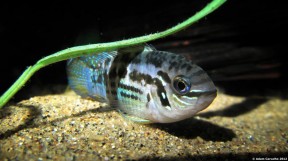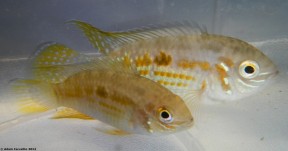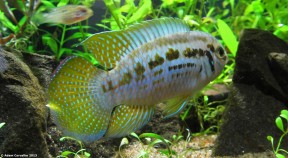Laetacara araguaiae
Etymology
Laetacara: from the Latin laetus, meaning ‘happy’, and acará, a vernacular term used for cichlids in certain parts of South America, in reference to patterning around the mouth and snout which give members of this genus a ‘smiling’ appearance.
araguaiae: named for the rio Araguaia, Brazil, to which this species is native.
Classification
Order: Perciformes Family: Cichlidae
Distribution
Known from the rios Tapajós, Xingu and Tocantins, all of which are right-bank tributaries of the lower Amazon basin in Brazil, with some populations exhibiting differences in colour pattern to one another.
Type locality is ‘Buriti palm near rio Verde, 32 kilometers north of São Miguel do Araguaia, rio Araguaia basin, Estado de Goiás, Brazil’.
Maximum Standard Length
The largest officially-recorded specimen measured 34.9 mm.
Water Conditions
Reproduction
Biparental substrate-spawner.
NotesTop ↑
This species was known as L. sp. ‘Buckelkopf’ in the aquarium hobby prior to publication of its official description.
The genus Laetacara currently contains seven valid species and L. araguaiae can be distinguished from all congeners by possessing 7-8 dorsal-fin rays (vs. 9–10 in L. dorsigera, L. fulvipinnis and L. thayeri, 8–9 in L. curviceps and L. flamannellus, and 9–11 in L. flavilabris).
It further differs from L. dorsigera by possessing a narrow ectopterygoid (vs. wide), lesser head depth (80.0–88.7 % mm HL vs. 90.2–96.3 % mm HL), a shorter snout (snout length 26.7–32.2 % mm HL vs 33.0–37.9 % mm HL) and more scales in the longitudinal series (23–25 vs. 21–22).
It can be told apart from L. curviceps, L. dorsigera and L. flamannellus by lacking a dark spot on the dorsal-fin base (vs. possessing), from L. thayeri by possessing cycloid scales on the sides of the head (vs. ctenoid scales)and presence of a dark spot at the caudal-fin base (vs. absence), from L. flavilabris by having fewer total vertebrae (24 vs. 26) and fewer scales in the upper lateral line (12–14 vs. 15–18), and from L. fulvipinnis by possessing fewer scales in the upper lateral line (12–14 vs. 15–17), fewer scales in the lower lateral line (6–8 vs. 8–9) and lack of a dark dot at the edge of each scale on the midlateral portion of the flank (vs. presence).
References
- Ottoni, F. P. and W. J. E. M. Costa, 2009 - Vertebrate Zoology 59(1): 41-48
Description of a new species of Laetacara Kullander, 1986 from central Brazil and re-description of Laetacara dorsigera (Heckel, 1840) (Labroidei: Cichlidae: Cichlasomatinae). - Ottoni, F. P., J. L. O. Mattos and I. Schindler, 2009 - Vertebrate Zoology 59(2): 123-129
Re-description of Laetacara curviceps (Teleostei: Cichlidae: Cichlinae). - Ottoni, F. P., P. H. N Bragança, P. F. Amorim and C. S. Gama, 2012 - Vertebrate Zoology 62(2): 181-188
A new species of Laetacara from the northern Brazil coastal floodplains (Teleostei: Cichlidae). - Staeck, W. and I. Schindler, 2007 - Vertebrate Zoology 51(1): 63-71
Description of Laetacara fulvipinnis sp. n. (Teleostei: Perciformes: Cichlidae) from the upper drainages of the rio Orinoco and rio Negro in Venezuela.








